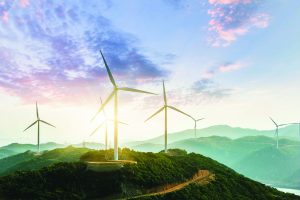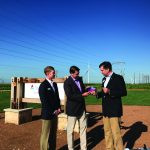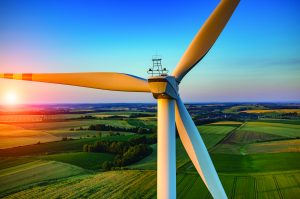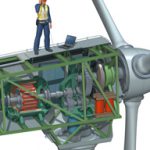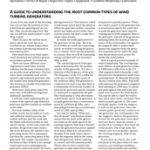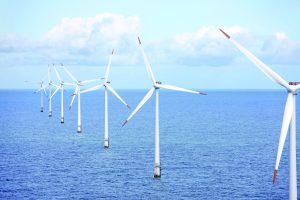As in other heavy industries that utilize rotating machinery, wind turbine operators have come to realize that effective monitoring of critical drive train components can enable proactive maintenance and ultimately reduce operations cost over the long-term life of the producing asset.
Some have characterized this as the evolution of the Operations & Maintenance (O&M) service organization from a reactive, fire-fighting approach to a predictive and optimized maintenance planning and execution mode of operation.
This evolution has not occurred overnight and it is has been a reaction to the various failures that operators have experienced on multiple projects across a wide cross-section of wind turbine types and models. Romax’s customers have realized and acted upon the notion that knowledge is power—whether in securing concessions from a manufacturer at an end-of-warranty discussion, negotiating renewals, or for budgeting for major repair and replacement where O&M is taken in-house.
Shadowing the OEM during the initial warranty period—thinking strategically for the long-term
A top-five global developer and owner-operator of onshore and offshore assets in the U.S. and Europe has engaged Romax to “shadow” the OEM for the duration of the initial warranty period. The operator approached Romax and made the decision to utilize the InSight monitoring service as a way to gain knowledge of their fleet’s “health.” While the assets are covered under the OEM warranty for the first few years, there is often not a good alignment of vendor priorities to owner-operator priorities for the long-term operation of the asset. This can lead to incomplete information sharing, less than optimal maintenance practices (e.g. the “hidden” bearing problem that blows up three months after end of warranty) and a focus on contractual issues and their associated implications; as opposed to doing what’s best for the long haul.
Romax Technology is monitoring this operator’s turbines 24/7 with vibration data, oil sample data, maintenance plans and records and other sources of data. These are combined in a manner that gives the operator a big-picture view of the past, present and future condition of their assets in a way that previously only the OEM would have been able to create. Having access to this range of “big data” has enabled this operator to negotiate from a position of strength with the OEMs, and better plan its operations and maintenance (O&M) budgets and projected spend when considering taking O&M in-house.
End-of-Warranty–Better Information Leads to Better Outcomes
One of the most critical transition periods in the life of an asset is when the OEM warranty is ending. Operators have many choices to make at this point; in order to make the best decisions for the long-term they need all the information they can gather about the current health of their machines.
Conducting a machinery health assessment with vibration measurements can be of significant additional benefit in providing data for the operator in negotiations with the OEM.
Typically at end-of-warranty (EOW) the operator will engage Romax or another party to perform detailed inspection of drivetrain components, hubs, blades and other large components in an effort to determine the state of the machine and any impending problems. For instance, wide-ranging gearbox borescope inspections are typically carried out (see Figure 1). However, it is difficult and time-consuming to see all contacting surfaces on all components, and it will not necessarily find all damage that may have occurred. Vibration measurements provide invaluable insight and help with focusing these inspections on particular gearboxes and particular components.
A U.S. operator recently engaged Romax to perform targeted EOW inspections. Romax first performed a machinery health assessment by thoroughly analyzing the CMS and SCADA data and then conducted inspections of particular gearboxes. The inspections confirmed excessive deterioration had occurred as predicted by the data analysis. Though the OEM had been monitoring the site as part of the warranty and O&M agreements, planet bearing faults were detected by Romax that had not been reported by the OEM. Detecting these faults enabled the operator to negotiate with the OEM from a strong position and get allowances for future gearbox repairs. Had this failure mode not been identified the site would have faced some very expensive repairs—challenging the already slim O&M budgets—instead of replacement under warranty.
Periodic Portable Vibration Sweeps–what you don’t know will definitely keep you up at night
Even after the EOW period is over, Romax recommend performing periodic vibration sweeps with portable vibration sampling equipment. Romax has developed and maintains its own equipment for use in these sweeps (see Figure 2).
Many of Romax’s customers who don’t currently have a permanent drivetrain vibration monitoring solution have requested a periodic “sweep” of either an entire wind farm or a subset population of turbines. The subset can be selected by reviewing prior sweeps and temperature data, oil/grease condition information and maintenance history. The periodic vibration sampling along with data from the other sources enables a trend to be developed which, combined with Romax knowledge of component failure histories and prognostics, can give the operator a clear view as to the future state of these components and consequently the costs that will be incurred to repair or replace.
Is it Worth Putting CMS in Your Turbines? A Few OEMs thought So
Most of the fleet of wind turbines installed in the US during the last 10 years did not have OEM installed Condition Monitoring Systems (CMS) as standard equipment. In those turbines where it is installed the OEM benefitted by being able to manage failures proactively in a cost effective manner. They also benefit from the data as it may be used for future product optimization. Such equipment was offered as an option by OEMs, however, and was not perceived to offer enough value to developers. It is still perceived by many operators as too expensive and there has not been much activity, with a few notable exceptions, in the retrofit of CMS to the installed fleet.
One of Romax Technology’s large global customers did make the decision a few years ago to retrofit their entire fleet with CMS as they determined a significant overall cost saving in doing so. The decision was made with a detailed calculation including the cost of the equipment, the detection efficiency, the predicted drivetrain failure rates and the future value of the cost savings enabled by early problem detections and associated cost avoidance. Figure 3
Perhaps the biggest driver of any decision to retrofit CMS is the cost of the hardware and the determination of the payback period for the capital investment. The price of CMS hardware including vibration sensors and data acquisition units is reducing, and Romax believe that CMS hardware and services are vital for minimizing the cost of energy from wind. The payback on the capital cost has been demonstrated and it should not be a barrier to wider deployment in the wind industry.
However, installing the CMS hardware is not enough; ensuring quality data analysis, proactive site support and excellent communication are key drivers to maintain the return on investment. Once hardware is installed, the Romax InSight software solution and Romax’s global team of experts can deliver monitoring, analysis and reporting services, utilizing the depth of knowledge of over 150 engineers delivering software and service solutions to designers and operators of rotating machines worldwide.
After the OEM is Gone–Is There a Better Way?
Many operators are now making a choice to not renew O&M services with their turbine OEMs. It is important not to lose the expert knowledge that the OEM has of “their” turbines during the transition. This knowledge is gained through access to operating data across their large installed fleet, and can be used for turbine-to-turbine and site-to-site comparative analysis. Often the OEM will not make an operator’s own site data, particularly from installed CMS, available to the owner without explicit language in O&M agreements.
As a way to mitigate any ongoing reliance on the OEM for a true picture of their sites’ “Machine Health,” many operators have engaged the Romax InSight team to take over the real-time monitoring of their sites, including periodic reporting on information from installed CMS systems (see Figure 4). Independent service providers and in-house O&M groups may not have staff with the specialized training needed to analyze the many gigabytes of data generated. Such groups are augmenting their internal capabilities by accessing Romax’s extensive experience in drivetrain design, root-cause analysis of failures, knowledge of vibration engineering as well as material and lubricant properties and their associated effects on performance. Specific examples of component faults and pending major catastrophic failures that Romax has identified for these customers are available in other publications, but suffice to say Romax has saved clients millions of dollars of expenses and lost revenues. Certainly over time these customers could have developed these capabilities in-house, utilizing the Romax InSight software tool, but in the near term the “catches” and savings have been real and quantifiable. Outsourcing monitoring to the Romax team of highly skilled engineers means that an operator can tap into the latest developments in fault-finding techniques and expert engineering knowledge on certain turbine types.
Where are you?
There is an old adage—“money can paper over all bad decisions”—which is fine provided you have a lot of money to begin with. Many wind farm operators in the U.S. inherited O&M budgets that were optimistically planned by development groups in their organizations. Their calculations were based on small, historical sample sets that did not translate well to the multi-MW, hundred-plus turbine sites that have been constructed more recently.
When faced with a budget that was constructed on a “best-case” scenario of wind turbines actually performing at their market power curves with little to no downtime for repairs or major component replacements, the operator is quite often left to borrow from the future to pay for today’s problems. A better way forward is to implement the proactive strategies discussed here as a means to measure, predict and adjust how sites are run and maintained. Utilizing the knowledge gained will enable an optimized maintenance planning process that is sustainable for the long haul.


















